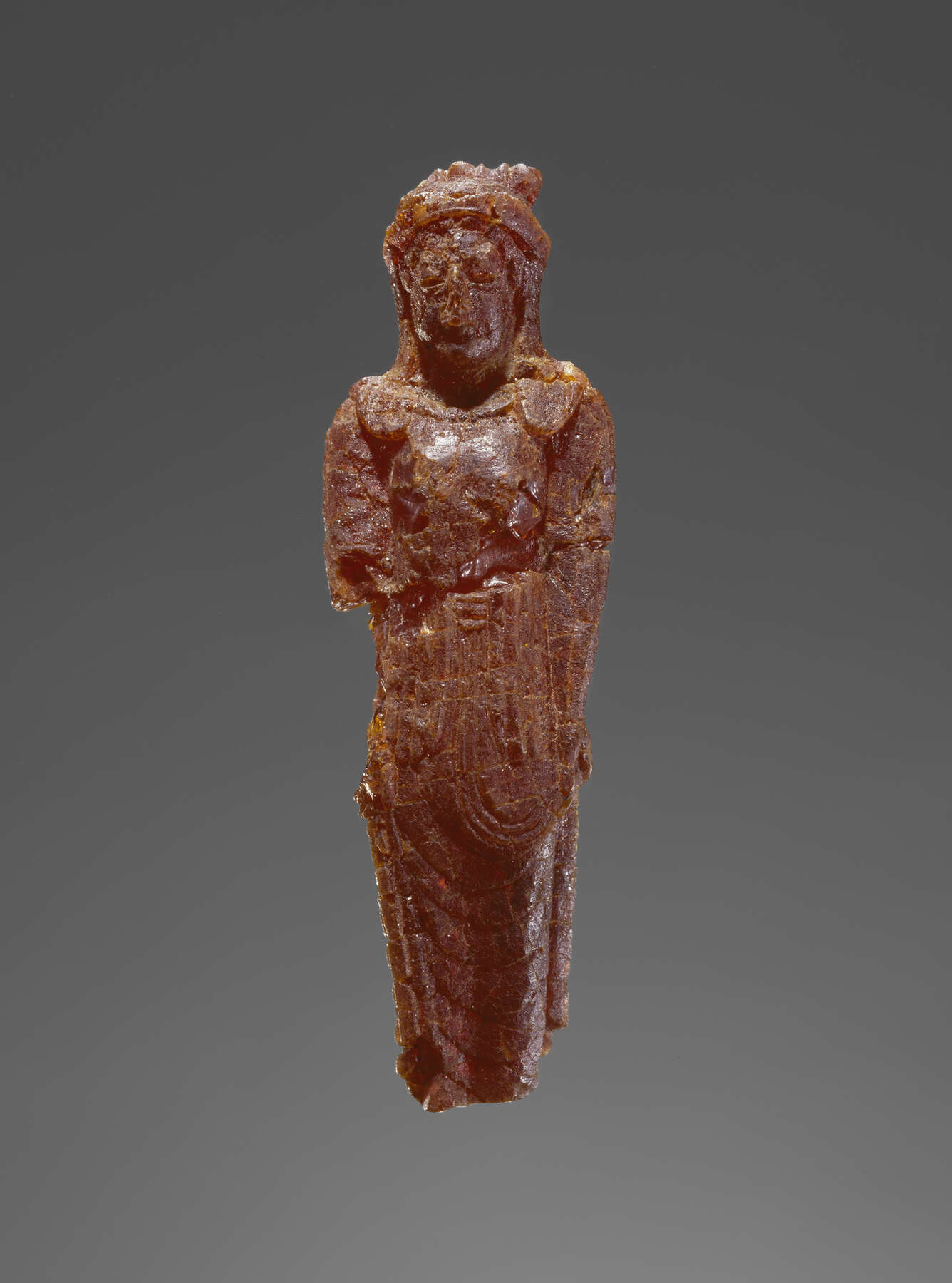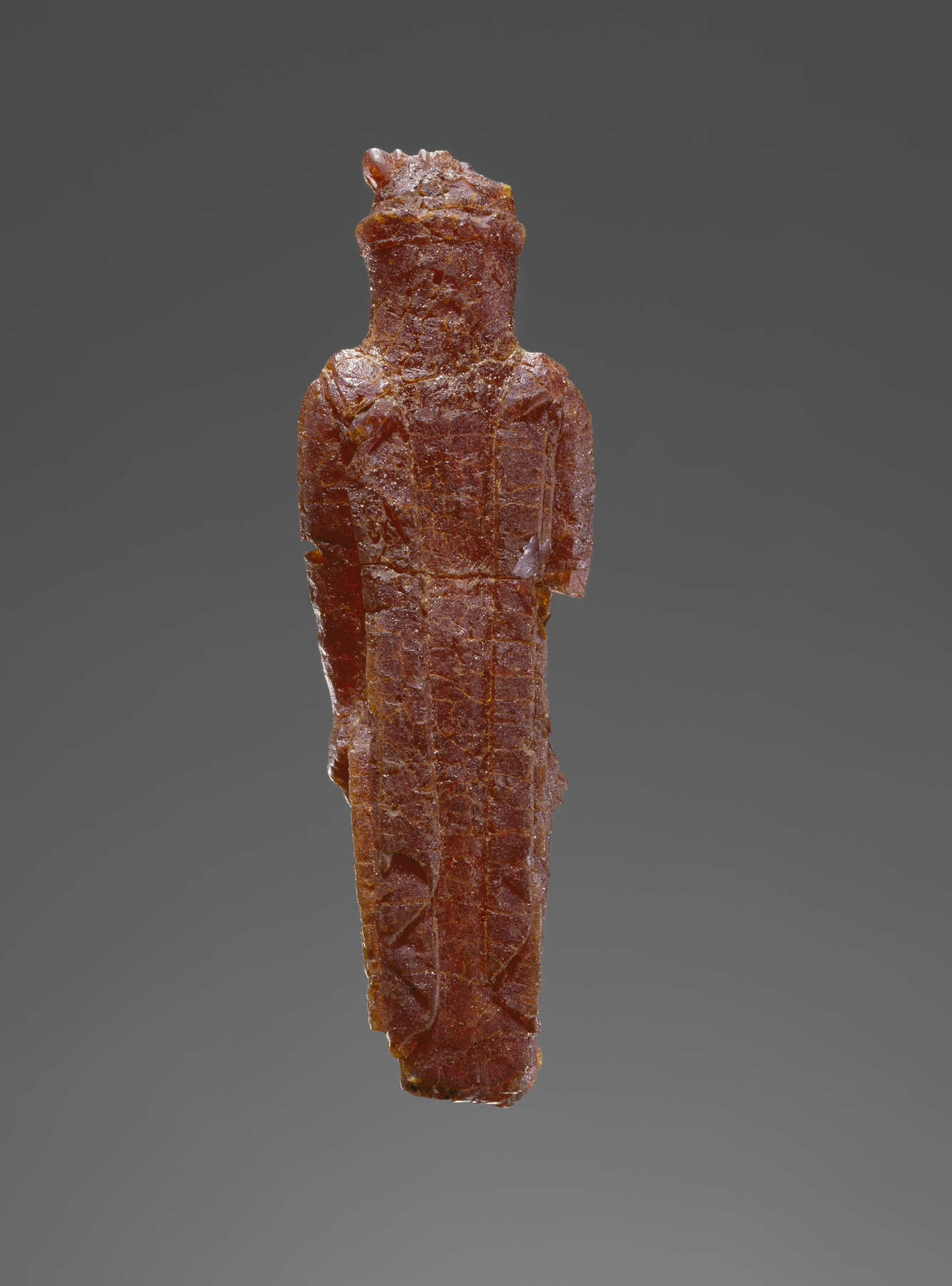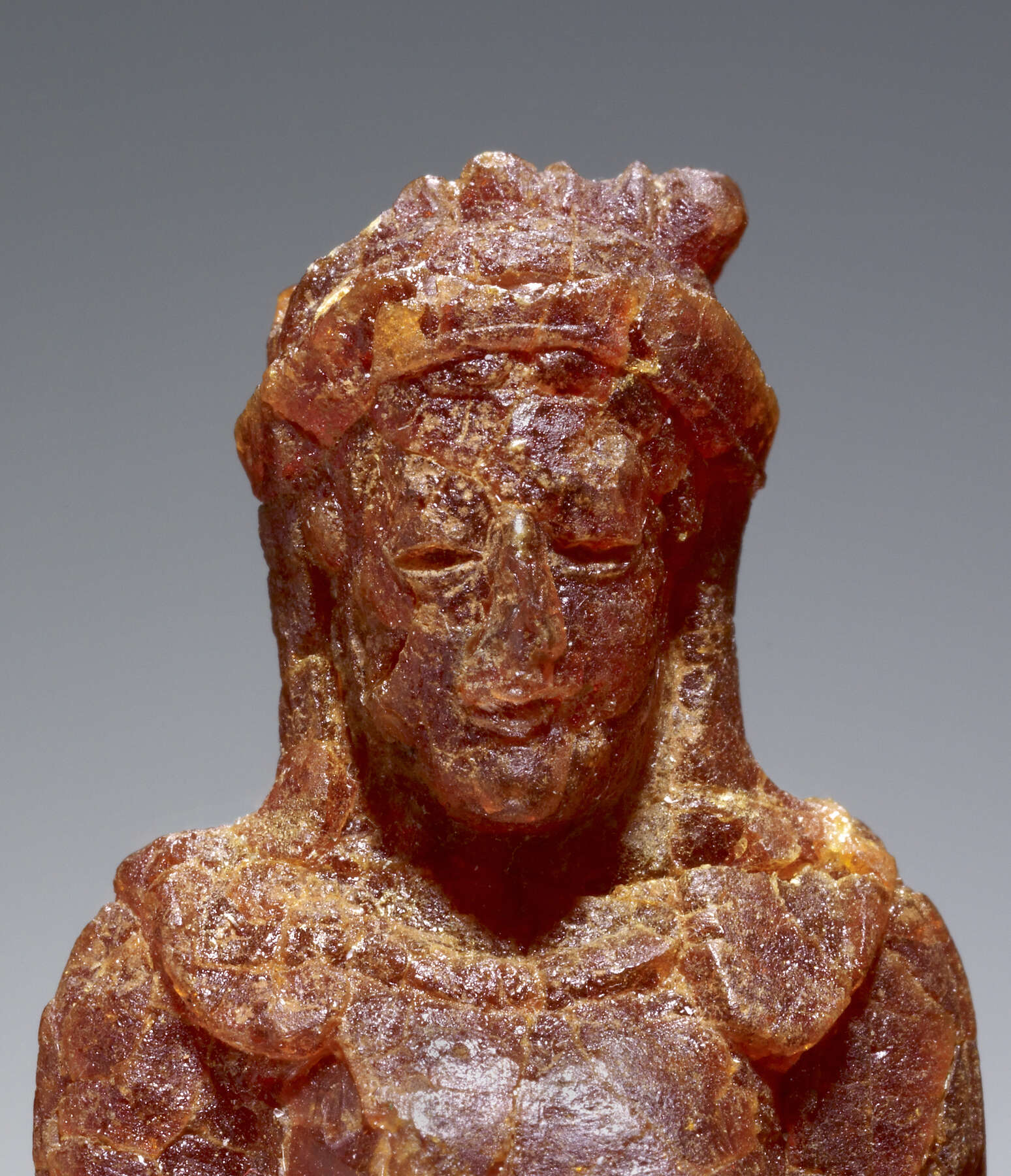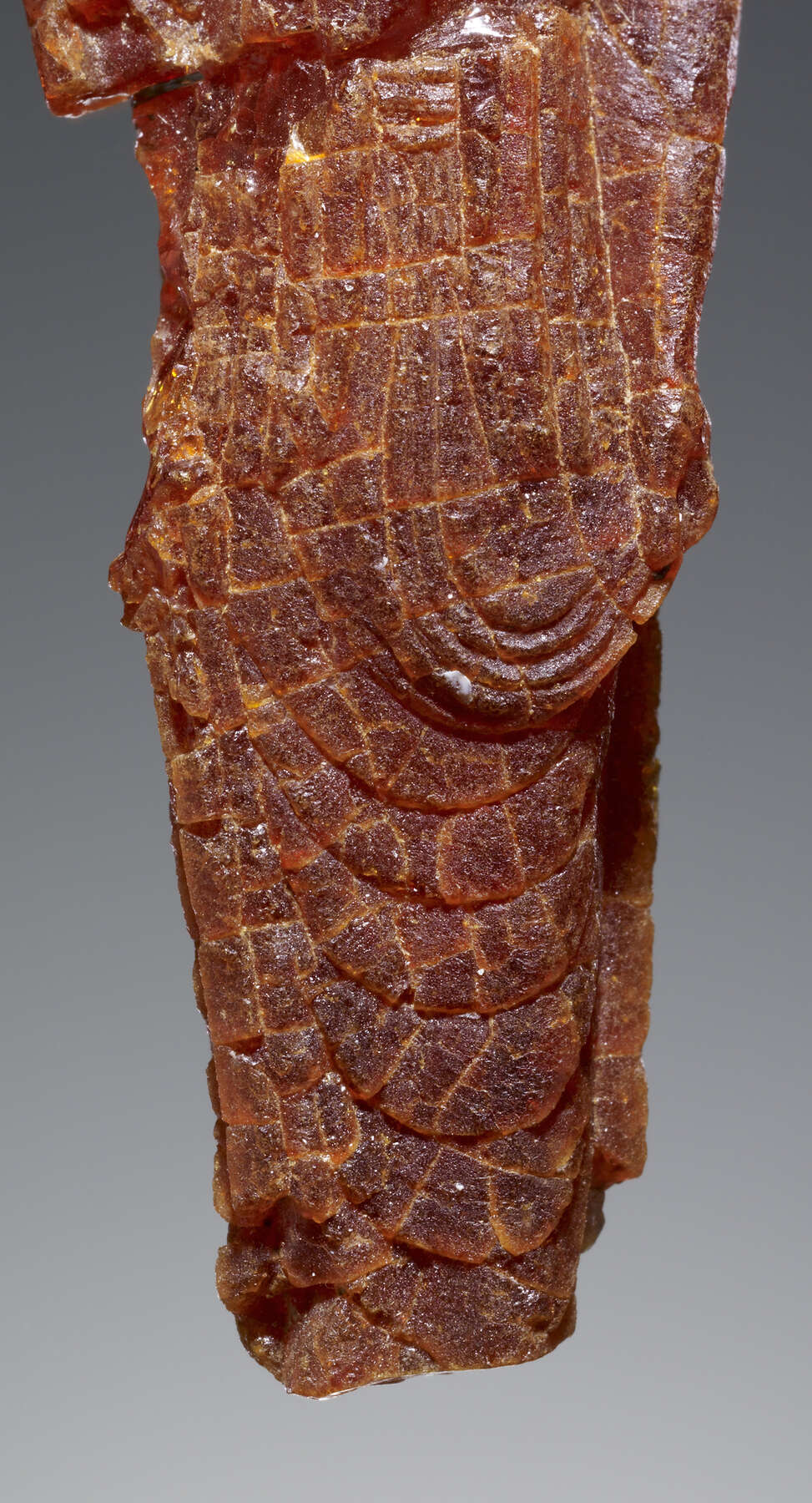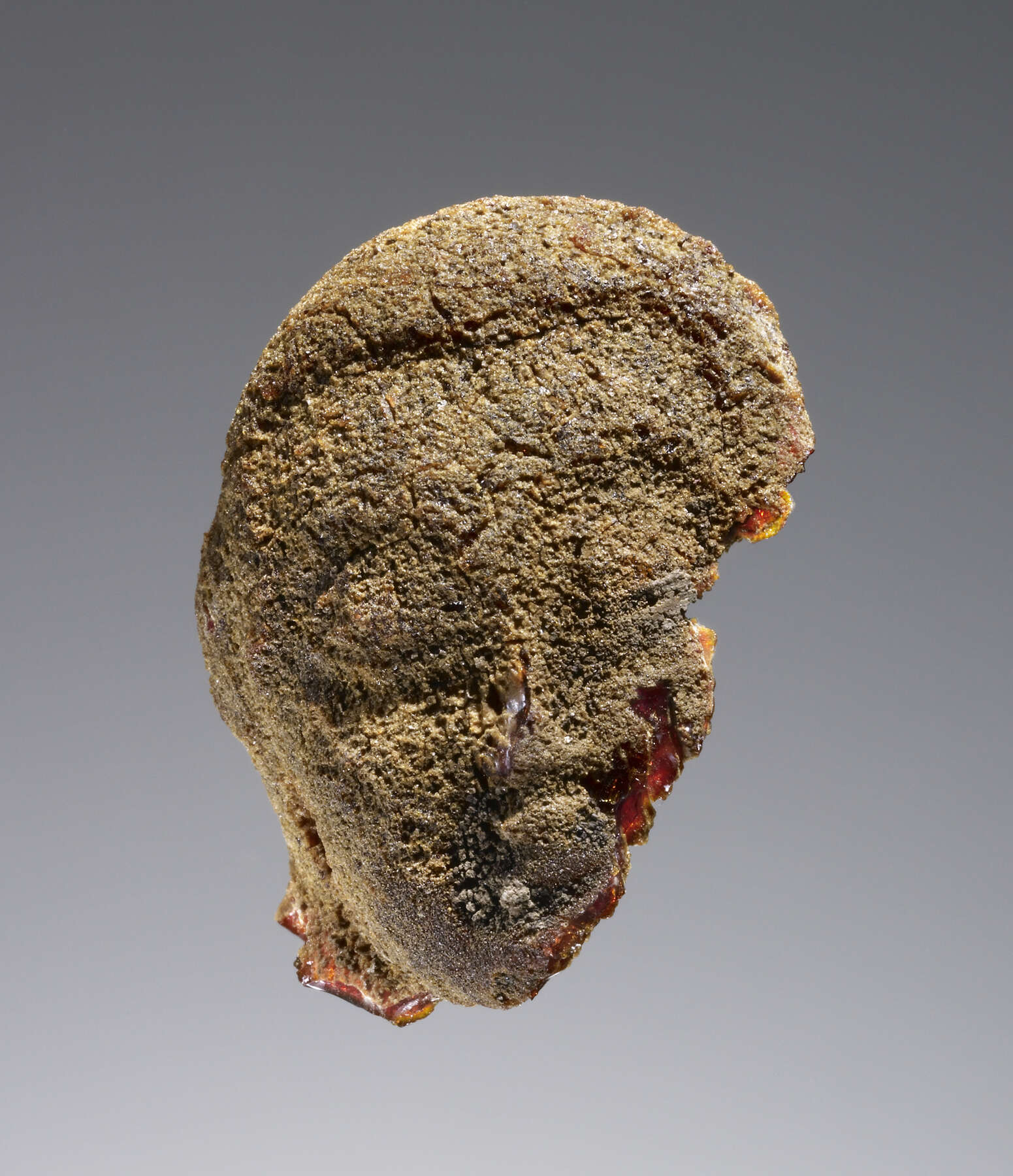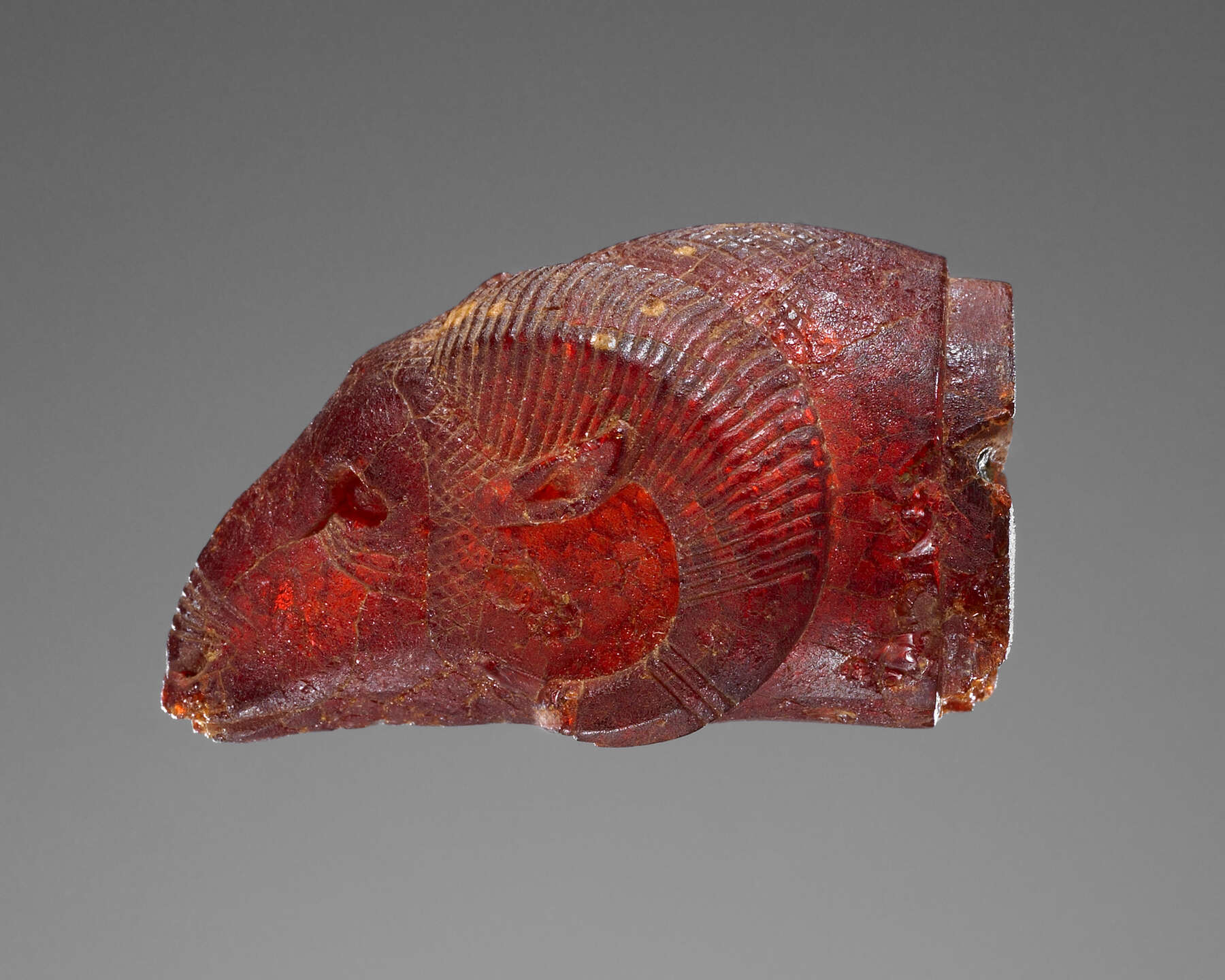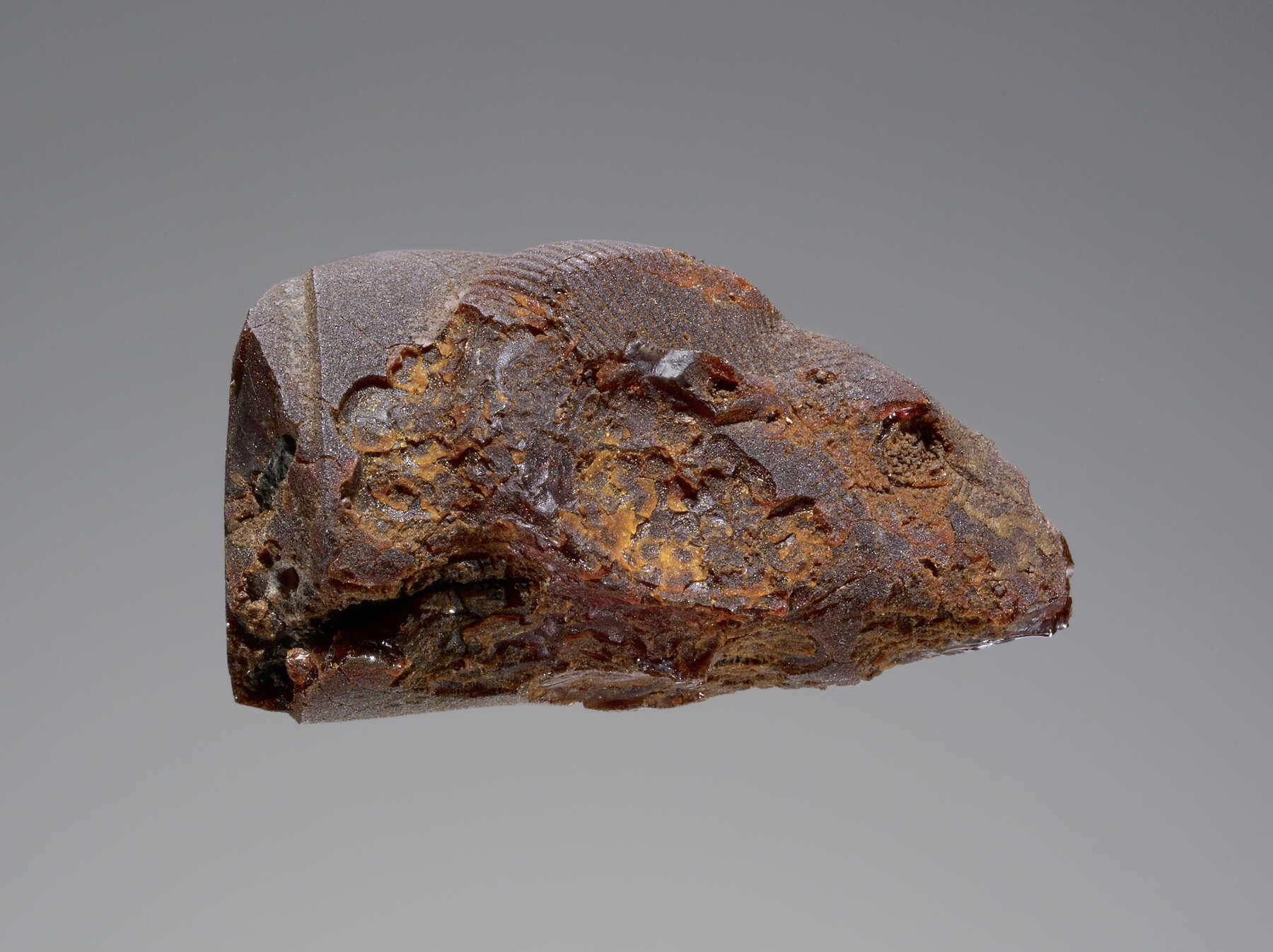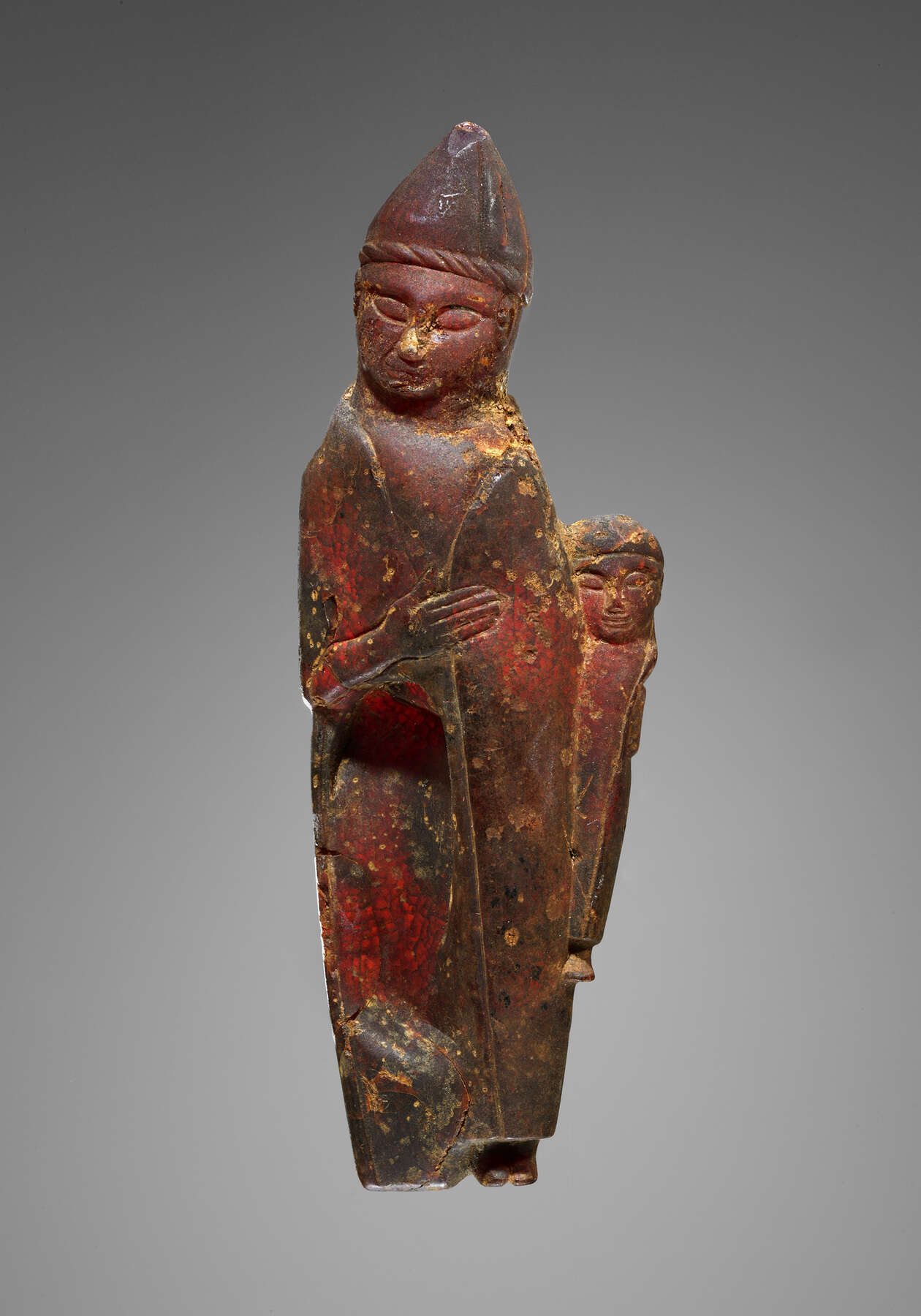8. Pendant: Standing Female Figure (Kore)
| Accession Number | 76.AO.77 |
| Culture | Etruscan |
| Date | 525–500 B.C. |
| Dimensions | Height: 67 mm; width: 20 mm; depth: 9 mm; Diameter of suspension holes: 2 mm; length: 9 mm; Weight: 6 g |
| Subjects | Artemis; Childbirth; Egypt; Fertility; Ionia, Greece (also Ionian, Greek); Magic |
Provenance
–1976, Gordon McLendon (Dallas, TX), donated to the J. Paul Getty Museum, 1976.
Condition
Upon acquisition by the museum, the piece (which had been broken at the waist and reglued) was cleaned mechanically and treated with an amber-oil distillate. The treatment resulted in improved translucency and slight darkening. There are pinpoint losses over all the surface and small breaks along the proper right side, on the veil, the right breast, and the right arm from elbow to hand; and along the left side, on a section of the veil and the upper torso below the breast and below the left elbow. There are also breaks on the stephane, or crown, and at the proper right of the flange. The bottom of the figure from the lower hem area to the feet is missing. There is a hairline crack around the neck and shoulders. Two small spalls on the reverse reveal unweathered amber. In ambient light, this pendant has a uniform dark orange-red translucency, and in transmitted light, a bright orange-red color. There are no visible inclusions.
Description
The amber has not been chemically analyzed, but its appearance is consistent with Baltic amber. The object is flat on the reverse and concave on the obverse, suggesting the form of the piece of amber from which it was worked, but there are no depressions or grooves. The lack of visible inclusions and flow lines suggests that it was carved from amber formed inside a trunk. The flange at the top of the head is drilled from both lateral sides toward the center for the insertion of a carrier. Under strong light, the two borings are distinguishable. Some areas preserve the multidirectional scratches caused by the use of a fine abrasive: between the arm and the bodice, on the long folds of the garment, and at the juncture of face and hair.
The figure wears a chiton with belt, a veil, a crown, and bodice jewelry. She holds the chiton skirt in both hands and poses with her left leg slightly in front of her right. Her face is a full oval, the brow smooth. The smallish, narrow eye sockets are shallow and empty and likely held inlays. The nose is indented slightly at the root and is set at a low angle relative to the forehead and chin. The cheeks are flattish and full. The mouth, formed in a half smile, has a short upper lip (with the tubercle indicated) that protrudes over a full lower lip indented slightly at the center. The nodes at the corners of the mouth and the mouth angle furrows are indicated by short, nearly vertical indentations. The mentolabial sulcus is shallow; the chin is small and round.
The hair framing the forehead is parted in the middle, and the two sections are dressed to each side in a series of four rounded waves, each undulation plastically swelled. Each side section is pulled over the top of the ear and then behind it. The figure’s hair is worn loose down the back in a fall that is curved at the bottom; it reaches the top of the thoracic vertebrae. Over her hair is a long veil of fine fabric. Atop the veil is a crown, worn at the position of the bregma. The pendant flange at the top of the head is carved with a bead and reel.
The torso section of the chiton falls into two vertical folds that overfall the waist in full sections as far as the position of her wrists. The skirt is drawn closely against the body. In her left hand, with her thumb over the cloth, she grasps the central portion of the chiton, which is delineated by three narrow pleats. In her right hand, the thumb also atop the cloth, she holds a section of the skirt, which is pulled horizontally. It forms a vertical section of several folds. The draping of the skirt forms six evenly spaced folds, patterned into almost parallel, horizontal sections. At the waist, three raised horizontal bands signify the belt. At the neckline is a curved raised area and, at about the clavicles, a pectoral ornament. It may be attached to the neck edge of the chiton or to the inside edges of the veil lappets. The joining up of the sides of the chiton to form “sleeves” is indicated on the tops of the sleeves by two adjoining parallel raised lines. The narrow hems at the elbow are clearly indicated. The veil falls forward to her shoulders, covers her ears, and forms deep lappets that reach to the level of her armpits. The veil leaves the tips of the shoulders free and drapes down her back in a straight fall to about the position of her ankles. In the back, the veil is patterned into a series of vertical pleats to a level just above the hem of the chiton. The center of the veil is flat, unpleated, and plain; the sides of the garment are turned back, folding onto the center portion. This results in the terminal edges patterning into swallowtails. Drop-shaped fabric weights (two) are discernible at the uppermost edges of the veil’s zigzag folds.
Discussion
76.AO.77 is comparable in style and dress to a number of much larger objects (marbles, bronze statuettes, and terracottas) as well as to a number of other tiny figures in the form of either a kore1 or a kouros made from other precious materials, including ivory and gold or silver sheet. The metal figures, in addition to serving as pendants, also adorned earrings, headwear, and dress. In addition to 76.AO.77, ten other miniature amber korai are extant. The ambers are all perforated, and seem all to have been designed to hang from carriers or pins. Nine are complete or nearly so, and two are fragmentary. The eleven ambers of female figures in the form of korai are (1) Malibu, J. Paul Getty Museum, 76.AO.77, figure in chiton and veil; (2) Perugia, Museo Archeologico Nazionale 101185, from Monteleone di Spoleto (Colle del Capitano), figure in chiton and himation;2 (3) Berlin, Staatliche Museen (Antiken Museen, lost during the Second World War), figure in chiton and veil;3 (4) Dresden, Albertinum 1384, larger figure in chiton, veil, and mantle;4 (5) Dresden, Albertinum 1384 (sic), smaller figure in chiton with mantle;5 (6) Belgrade, National Museum 689/1, from Novi Pazar, St. Peter’s Church, kore in chiton, veil, and mantle;6 (7) Belgrade, National Museum 688/1, from Novi Pazar, St. Peter’s Church, kore in chiton, veil, and mantle;7 (8) Belgrade, National Museum 692/1, from Novi Pazar, St. Peter’s Church, kore in chiton and mantle;8 (9) New York, Metropolitan Museum of Art, Philanthropic Fund, fragmentary figure in chiton and veil;9 (10) Basel, Switzerland, private collection, kore in simple chiton;10 and (11) Malibu, J. Paul Getty Museum, (cat. no. 9), fragmentary figure in chiton and veil. A related amber is the two-figure pendant in New York, a draped woman in chiton and mantle holding a child (the child’s head is now missing), a kourotrophos.11
Only four of the above have secure documentation, the three from the large Novi Pazar “princely” burial and the single figure from a disturbed burial at Monteleone di Spoleto. Robert Heidenreich recounts that the Dresden ambers came from a grave near Rome. In the Getty Museum collection, 76.AO.77; three of the ram’s-head pendants, (cat. no. 39), (cat. no. 40), and (cat. no. 41); and a pendant with the foreparts of a boar, (cat. no. 37), are related in style, technique, and state of conservation and are alike enough to consider the hypothesis that they may have been found in the same burial. The combination of subjects is plausible, given that the Novi Pazar burial included three korai and eighty rams’ heads.
The pendants that retain their feet (all but 76.AO.77 and one of the kore from Novi Pazar, National Museum 688/1) appear to be wearing smooth, pointed boots. The Berlin and the larger Dresden korai stand on plate bases, but the lower part of the amber from Monteleone di Spoleto is difficult to discern. Apart from the three kore from Novi Pazar, which were perforated for suspension in the feet area, all of the complete pendants were suspended from the head.12 The suspension flange on 76.AO.77 closely matches that of an amber kouros pendant in London (British Museum 41). The only other kore pendant with a flange is the smaller Dresden draped female.
These objects and those in precious metal and ivory display a similar compact sculptural form, indicating that they were designed to be worn. The korai are typified by short, thick necks, long hair or veils, wide shoulders, long garments, legs and small feet close together, and arms and hands attached to the body. Some have plate bases. The nude kouroi stand with one leg slightly forward, a pose that helps the carver close the gap between the legs. These sculptural solutions provide extra support for potential weak spots such as the neck, arms, or feet.
76.AO.77 has features in common with each of the other pendants, but it is most like the similarly sized Berlin pendant. There is no extant photograph of the reverse of the Berlin figure, but the two korai are similar in contour, volume, stance, and hand position, as well as general body proportions: large head on diminutive neck (their heads make up roughly a fifth of their total height), wide shoulders and full upper arms, and a short stature. Both wear chitons with deep kolpoi and have similar long, capelike veils with lappets of cloth on the front and shoulders. Although the two pendants are close in style, and probably descend from a common artistic tradition, there are notable differences between them. Whereas 76.AO.77 has a bead-and-reel flange carved as part of the piece, the Berlin amber has a carrier hole bored through the head from temple to temple. The Berlin amber is more cursorily modeled than 76.AO.77. The expression of the Getty figure suggests the beginning of a smile; the face of the Berlin amber communicates greater gravity. (Is it a question of age?) The larger of the Dresden amber pendants is also veiled, but the veil does not form frontal lappets. 76.AO.77 and the Berlin, Dresden, and two of the Novi Pazar figures (688/1 and 689/1) are holding folds of drapery in both hands. Novi Pazar 689/1 displays the most marked instance of cloth grasping (as if the figure is starting a curtsy). The woman of the New York kourotrophos pendant balances the child with her right hand and holds the cloth of her garment in her left (a gesture mimicked by the child’s left hand). 76.AO.77 and the other extant amber korai and kouroi (including the Novi Pazar ambers) were probably carved in Italy. The similarities of style and form among the amber korai suggest that there is a common invention behind them. The particularities of the dress and adornment of 76.AO.77 help to locate its origins.
The kore’s chiton—belted, with long kolpoi, an emphasized verticality in the portrayal of the bodice folds, and a central bunching of folds—finds its best parallels among Ionian marbles, including (1) the figure on a votive relief from near Cyzicus (Berlin, Staatliche Museen 1851); (2, 3) two fragmentary marble korai figures from Miletos (Berlin, Staatliche Museen 1577 and 1744); (4) a marble from Didyma (Berlin, Staatliche Museen 1793); and (5) a Milesian-influenced marble from Theangela, Caria (London, British Museum B319).13 The amber kore displays the South Ionian marble sculptors’ feeling for the thickness of the chiton’s fabric and a correspondingly rich plasticity in the modeling.
The kore’s long veil is distinctly South Ionian, and perhaps characteristic of Miletos. The cloth surrounds the face and neck, covering the ears before falling down the back.14 Two small lappets are formed at the shoulders, so that the presence of the garment is obvious from a frontal view.15 In contrast with the tighter Samian arrangement, “around the temples the veil swells to suggest the hair underneath.”16 Characteristically South Ionian (and perhaps even distinctly Milesian rather than Samian) are the zigzag folds of the veil.17 The cloth weights attached to the ends of the veil show how well the carver understood the light garment. 76.AO.77, which can be viewed in the round, may be one of the best available illustrations of the Ionian long veil, since all of the other extant examples from the area are partial figures or are represented frontally on reliefs.
The physical type might also be said to be Milesian. Analogues for the head include a group of terracottas attributed by F. Croissant to Miletos: two in London (British Museum 205 and 206), one in Athens (National Archaeological Museum 5669), and one in Paris (Louvre MNC 681),18 which show a similar emphasis on horizontality in the design and placement of the features. The serene faces all communicate a sense of an immediate and living presence. Four marble heads, one from Miletos (Berlin, Staatliche Museen Sk 1631),19 one from Samos (Berlin, Staatliche Museen Sk 1874),20 one from Miletos(?) in Paris (Louvre Ma 4546),21 and another in İzmir (Archaeology Museum 15136),22 are similar in anatomical structure to 76.AO.77. The eyes of the tiny amber, though different in being hollow, are still distinctively alike in form.
The hairstyle appears to be unusual, but this may be owing to a paucity of comparisons. The curved lower contour is distinct from the common horizontal termination. Comparable coiffures on Greek kore figures include an early-sixth-century terracotta in London said to be from Tanagra, a marble kore from Andros in Copenhagen, a late-sixth-century bronze mirror stand in London (said to have been found in Rome), and a late-sixth-century (with later interventions) marble kore in New York, said to be from the neighborhood of Laurion.23 The hair of the late-sixth-century B.C. marble Leto found in the Delian temple of Artemis (Athens, National Archaeological Museum 22)24 is slightly longer than that of 76.AO.77, but the bottom-edge contour is the same. This “pageboy” style is seen more frequently on Middle Archaic votive bronzes (both korai and kouroi) in Etruria than among Greek Archaic korai. The most relevant examples include the Middle Archaic korai in Florence (Museo Archeologico Nazionale 266 and 231), and an unnumbered bronze in the Villa Giulia, Rome.25 The Etruscan absorption of this style may help to locate where 76.AO.77 was carved.
Who is represented in 76.AO.77? It is hypothesized here that the amber represents a goddess. The material of the pendant and the crown determine its divine identity. If the figure represents an Olympian, Artemis, Leto, Aphrodite, and Eos would be possibilities. Each one is a brilliant goddess associated with light. However, details of the hairstyle and dress, and the South Ionian or even more specifically Milesian style, may preclude any identification other than Artemis or Leto. The veil and hairstyle, and perhaps the breast jewelry, are significant.
Although there is disagreement among scholars about the meaning of the veils worn by kore figures, they are generally agreed to be of considerable significance. Since, as Brunilde Ridgway summarizes, the kore type originated “probably as a divine image … heavily indebted to Oriental prototypes, both in rendering and in items of clothing[,] … [which was] further exploited to portray specific goddesses, usually by the addition of an attribute or extra garment,”26 the context, the attributes, and the details of dress are all important. For Ridgway, the Leto from Delos raised questions about the interpretation of all East Greek and Samian veiled korai, and she came to the conclusion that the veil drawn over the head must imply more than regional fashions, that it
must at least stand for matronly status or even outdoors versus indoor attire.… Even strict dependence upon Oriental religious iconography would not ensure a similar divine identification for all of [them] … [but the] possibility however exists, and we should be open to it since we have too easily extended to all female figures that generic meaning of agalma which, to be sure, applies to many of them.27
Lloyd Llewellyn-Jones summarizes the evidence for veiling in Greece and shows the multivalency of the veil’s meanings, including a woman’s place in the social order.28 He reviews the complex range of the Greek terms for “veil” and the difficulty of matching them up with their artistic counterparts. Nevertheless, it is tempting to identify the veil of 76.AO.77 as the delicate and glistening ampekhonē.29
Besides the veil, the marble Leto from Delos wears another distinctive element, a double chain ornament (which once supported six pendants) that attaches the two veil lappets together like an old-fashioned sweater chain. 76.AO.77 wears a single, pendantless ornament across the breast. Is it attached to the garment, or does it secure the two lappets? In the final argument, Ridgway identified Athens 22 as Leto, partly because of the veil, and partly because of the marble female figure found with it, which she identified as Artemis. (There is no comparable jewelry on the smaller marble.)
The hair of Athens 22 is worn long and, like that of 76.AO.77, is curved at the bottom, which, as noted above, is not common in Greek sculpture, being more frequently seen in Archaic Etruscan small bronzes. This, and the formulaic rendering of the skirt of 76.AO.77, may aid in further situating the amber and even help to identify which divinity is represented.
The formula of representing a chiton skirt of fine fabric drawn into near-parallel folds is found on many marble representations of South Ionian female figures, standing and seated; examples are a votive relief and a fragmentary torso from Miletos.30
This is very similar to the patterning of horizontal folds found on Etruscan kore figures (even on figures with the feet placed close together). Two key parallels for the chiton skirt of 76.AO.77 are the Etruscan veil-wearers in Emeline Richardson’s Tomba del Barone group of bronzes, and a superb “Ionian” bronze kore from Rimini in Copenhagen.31 A very similar presentation of the chiton skirt is found on a number of sixth-century Etruscan (Caeretan?) gold plaquettes of korai, with three said to come from Cerveteri and one from Palestrina.32 The divinities (since they are crowned and made from gold, they must be divinities)33 fill the rectangular aediculae of the plaquettes, and in the London pair, the slope-sided hats overlap the edge. The gold figures wear diadems with colored glass or paste inserts, and the London pair each wears a necklace from which hangs a large inlaid pendant. The conical hats of the Etruscan examples are critical for the figures’ identification: are they Artemis?34 These Etruscan objects are further evidence of the impact of South Ionian artisans in Etruria, perhaps the same ateliers responsible for 76.AO.77 and the other extant amber korai and kouroi, including the Novi Pazar ambers.
The chiton grasping is a significant gesture of 76.AO.77 and all other korai figures and is a subject of considerable discussion. Helmut Kyrieleis has established the point that sculpted korai may represent movement in stasis (and not lose their essential meaning) in the way that a running or hunting Artemis painted on a Greek vase can communicate violent movement.35 Read as if it were an Egyptian image, 76.AO.77 (and related images) represents a pose frozen at the most important or recognizable part of a ceremony, which “can only be understood in terms of the meaning of the larger ritual in which it was embedded.”36 For the tiny amber korai, is the pose frozen in running or dancing, specifically cultic and ritual dance? If a dance, lines from the Homeric Hymn to Artemis might be recalled:
This huntress who delights in arrows slackens her supple bow and goes to the great house of her dear brother Phoebus Apollo, to the rich land of Delphi, there to order the lovely dance of the Muses and Graces. There she hangs up her curved bow and her arrows, and heads and leads the dances, gracefully arrayed.37
The active pose, the “attributes” of transparent clothing, veil, crown, chain, and long loose hair, and the material of 76.AO.77 suggest that the tiny pendant represents specifically Artemis or Leto. Given that Leto, like her daughter Artemis, is a birth goddess, and given the age-old association between amber and childbirth, it is likely that 76.AO.77 and her kin served as special ornaments, ones with fertility aspects, either in direct magic or as powerful danger-averting amulets. The clinging transparent clothing and the position of the figure’s hand on the skirt both emphasize the pubic area, the location of the primary sex characteristic. This composition is comparable to the Egyptian manner of representing elite adult female fertility figures in the cases where nudity was inappropriate.38 A fertility subject represented in a substance associated with fertility would enhance the meaning of the object, since subject and material are inextricably intertwined in all ancient amulets. Here the subject might well function as did its Egyptian counterparts, the fertility figures linking the process of giving birth in this world with that of being reborn into the next. If 76.AO.77 and the amber animals were originally buried together, the group might be compared to the more complex precious metal plaques from the eastern Mediterranean, such as the numerous multisubject Rhodian plaques (seventh century B.C.),39 or a work like the semicircular gold plaque (Island Greek work) from Aydın (Tralles) of circa 600 B.C.40 The most complex of the Rhodian ornaments include female figures (clothed or nude), human heads, animals and animal masks, pomegranate blossoms and other flowers, or solar symbols. A winged Potnia Theron with felines and a centaur grasping a fawn are also common subjects. The Aydın pendant is among the most elaborate compositions: the female figure is in the “mastery of the animals” pose and is joined by griffin’s, bull’s, and ram’s heads and nonfigural solar imagery.
Much remains to be understood about the origin, meaning, and function of the large-scale kouroi and korai, but it appears that these sculptural types could serve both as votives and in funerary roles, to represent a divinity, a heroized dead person, or an idealized youth. Both kore and kouros could be a pleasing offering, an agalma.41 Furnished with suitable attributes, the kore or the kouros could become a hero or divinity: one of the Dioskouroi, Apollo, or Athena, for example.42 While much has been written about the life-size and larger korai and kouroi, there is a relative paucity of discussion about the miniatures.43
76.AO.77 and the other amber korai may have served for the living as well as for the dead, in body adornment, as amulet and ornament, roles that the large-scale objects were never called upon to play. The compact format of the pendants, the incorporation of suspension devices or plate bases into their designs, and the occasional evidence of use wear (rubbed surfaces, as on the Novi Pazar and Berlin korai), replacement of suspension holes (as might be argued for the Novi Pazar korai), or enlargement of the stringing holes (as on the Basel kore) suggest a significant use in life (or lives) before interment with the deceased. The ultimate “user” actually may have been the deceased. These tiny korai also may have been gifts and thus part of the funerary rituals. For the works that show no signs of wear, it is possible that they were made expressly, or acquired especially, for setting on the body or for placement in the grave at the time of burial. In death, the amber korai might have provided aid and protection during the fraught journey to the afterworld, if the beliefs attendant on such uses were current in Italy as they had been for millennia in Egypt.
Notes
- The term “kore,” commonly used for the many kinds of images of Archaic standing draped females, is misleading but useful. See, for example, , pp. 85–86. ↩
- This kore pendant is one of two ambers (the other, 101184, is a bust of a female, possibly a siren) found in the disturbed sixth-century B.C. Tomb 21 from the group excavated at Monteleone di Spoleto, Colle del Capitano: see Gens antiquissima Italiae: Antichità dall’Umbria a New York, exh. cat. (Perugia, 1991), pp. 175–76, 356, fig. 3.4. M. C. De Angelis, “La necropoli di Colle del Capitano: Nuove acquizioni,” in Romagna tra VI e IV secolo a.C. nel quadro della protostoria dell’Italia centrale: Atti del Convegno (Bologna, 1985), p. 288, fig. 9, considers the ambers to be local products influenced by the amber-working of the Basilicata. ↩
- , p. 655, pl. 9.1 (Bernsteininventar Nr. 1). ↩
- Ibid., p. 655. ↩
- Ibid. ↩
- , p. 136, no. 47, with earlier bibl. ↩
- Ibid., p. 137, n. 49, with earlier bibl. ↩
- Ibid., p. 137, n. 48, with earlier bibl. ↩
- Metropolitan Museum of Art 1992.11.21, Purchase, Renée and Robert A. Belfer, Philanthropic Foundation, Patti Cadby Birch, and The Joseph Rosen Foundation, Inc. Gifts and Harris Brisbane Dick Fund, 1992. ↩
- Unpublished. ↩
- , p. 32, figs. 104, 105. ↩
- The orientation of the figures may be significant. If the objects were perforated to hang feet upward and head downward, the orientation may have been purposely danger-averting, as it makes reference to the underworld (the opposite, or mirror, world of the dead). Alternatively, the orientation may allude to the nocturnal rather than just the diurnal phases of the sun or moon—that is, to their complete passage. ↩
- For Berlin, Staatliche Museen 1851, see , p. 93, no. 165; for Staatliche Museen 1577, , pls. 46 a–b, 47 c–d; and , p. 92, no. 161; for Staatliche Museen 1744, , pl. 22; for Staatliche Museen 1793, , p. 92, no. 162; for London, British Museum B319, , pl. 51 a–d; , pp. 127 (L84), 150, 186; and , p. 93, no. 167. ↩
- , p. 97. ↩
- The lappets that form on the shoulders of a figure from a relief found in Caltidere (Myrina) in the İzmir museum (which E. Akurgal dates to about 570–560 B.C.) are very like those of the amber kore: see E. Akurgal, “Bemerkungen zur Frage der örtlichen und zeitlichen Einordnung der griechischen archaischen Grossplastik Kleinasiens,” in Studies in Classical Art and Archaeology: A Tribute to Peter Heinrich von Blanckenhagen, ed. G. Kopke and M. B. Moore (Locust Valley, NY, 1979), p. 38, pl. 8.12. ↩
- , p. 97. ↩
- See, for example, , pp. 40–41. ↩
- , chap. 2, group B. ↩
- Berlin, Staatliche Museen Sk 1631: , p. 59, no. 95, figs. 293–95; and , passim, pl. 1. ↩
- Berlin, Staatliche Museen Sk 1874: , pl. 19; , p. 60, no. 98, figs. 30–45. ↩
- Louvre Ma 4546: , p. 57, no. 49. ↩
- İzmir Archaeology Museum 15136: , pl. 50; and E. Akurgal, Mitteilungen des Deutschen Archäologischen Instituts, Istanbuler Abteilung 42 (1992): 67ff. ↩
- For the Tanagra terracotta (British Museum 75.39.20), see , p. 102, no. 61, 204–5; for the Copenhagen kore (Ny Carlsberg Glyptotek 1544), , pp. 56–57, no. 13; for the mirror stand (British Museum 242), , p. 109, fig. 661; for the New York marble kore (Metropolitan Museum of Art 07.286.110), , p. 85, no. 138, figs. 441–44. Also compare the torso (from Paros?) in New York (Metropolitan Museum of Art 07.306): , p. 89, no. 151, figs. 483–86. ↩
- , p. 111. For relevant discussion of the pair from the Dodekatheon on Delos, see F. Zafeiropoulou, Dīlos: Martyries apo ta mouseiaka ekthemata (Athens, 1998), p. 225, no. 72; P. Jockey in Sculptures déliennes, ed. A. Hermary et al. (Paris, 1996), pp. 48ff., nos. 18–19; and , p. 167, n. 56. ↩
- For Florence, Museo Archeologico Nazionale 266 (votive deposit at Fonte Veneziana, Arezzo), see , p. 262, figs. 588–89; for Florence, Museo Archeologico Nazionale 231, ibid., pp. 63–64, figs 597–98; for the Villa Giulia bronze, ibid., p. 264, figs. 601–2. ↩
- , p. 114. ↩
- Ibid., p. 112. has made a strong case for the veil being worn during religious festivals. ↩
- L. Llewellyn-Jones, Aphrodite’s Tortoise: The Veiled Woman of Ancient Greece (Swansea, 2003). See also D. L. Cairns, “The Meaning of the Veil in Ancient Greek Culture,” in , pp. 73–94; ; U. Kron in , p. 56, n. 30; K. Tuchelt in ibid., pp. 32ff.; and , passim, on the meaning and interpretation of the veil as it relates to the kore. As Llewellyn-Jones 2003 outlines, the outer garment could denote stages in a woman’s life cycle and appears to have played various social and symbolic roles throughout Greek culture. In Homeric epic, noblewomen (and in notable cases their serving women), the focus of the cycles, wear the veil, and in seventh-century B.C. painting, goddesses (Athena and Aphrodite) and well-born wives (Eriphyle and Helen) are depicted with various types of outergarments worn over the head. A girl’s passage to womanhood was marked by her use of the veil; she offered her veil to Artemis on the eve of her wedding (when the bride comes under the protection of Aphrodite) before donning a special matrimonial veil; and as a married woman she wore a veil in public, going without it only in the first stages of mourning. ↩
- Might the veil of the amber kore be the ampekhonē (or ampekhonon), the fine, expensive outer garment, most probably a veil, noted in antiquity for its delicacy and semitransparency? Llewellyn-Jones 2003 (in n. 28, above), p. 27, notes that although in texts ampekhonē is noted as associated with hetairai (prostitutes) and even an Arcadian shepherdess, it has divine associations. It is listed among the textile dedications to major goddesses, in several cases at sanctuaries of Artemis. “On the Athenian Akropolis, an ampekhonē is recorded as being draped over the statue of Artemis.… The word occurs three times in the clothing inscriptions at the Artemis Brauronia sanctuary: on two occasions the garment is draped around the statue.… One of [them] has woven into it, ‘sacred to Artemis’”: ibid., pp. 27–28. ↩
- Some examples are Berlin, Staatliche Museen 1792 and 1898 (, p. 51, no. 72), and an unnumbered marble (ibid., p. 51, nos. 70–71). ↩
- For Richardson’s Tomba del Barone group (her Late Archaic Series A, Ionians, Group 2), see , pp. 283–85. For Danish National Museum 4203 (from Richardson’s Late Archaic Series A, Ionians, Group 1A, Traditional Sturdy series), see ibid., pp. 279–80, fig. 651. The Danish bronze has many older and unusual features. She wears two crescent-shaped diadems, one in front, one in back; two chitons and an Ionian diagonal himation; and scalloped waves around the face, two curls to each side, and a long fall in back. She holds her right hand on her breast, fist closed. Does the bronze represent an older type of statue, perhaps a cult figure, with an accumulation of related ornaments and dress? ↩
- Two of the plaquettes are in the British Museum (Jew. 1267–68, said to come from Cerveteri), and two are in Rome (Museo Nazionale Etrusco di Villa Giulia 40875, said to come from Cerveteri, and 53492, from Palestrina, Castellani Collection: , pp. 300–301, nos. 192–94). Decorating some slightly earlier sixth-century gold earrings in Berlin (Staatliche Museen 30219, 442 a/b) are figures of Potnia Theron; she lifts high the left side of her skirt with her left hand, places her right hand on her breast, and stands between lions: ibid. pp. 291–92, no. 142. ↩
- L. Khalil ( 2 [1984], s.v. “Artemis,” pp. 738–40) surmises that the tiny gold images found in the sanctuary of Artemis at Ephesus probably represent the goddess herself, because of the precious material of which they are formed. ↩
- For discussion of the conical hat and Artemis, see (cat. no. 1). ↩
- H. Kyrieleis, “Der Tänzer vom Kap Phoneas,” Istanbuler Mitteilungen 46 (1996), pp. 119–20, n. 43; also noted by , p. 50. ↩
- , p. 205. ↩
- “To Artemis,” XXVII, from Hesiod: The Homeric Hymns and Homerica, trans. H. G. Evelyn-White, Loeb Classical Library 57 (London, 1914). ↩
- On the representation of transparently robed elite female figures in Egypt, see G. Robins, “Dress, Undress, and the Representation of Fertility and Potency in New Kingdom Egyptian Art,” in , pp. 27–40. ↩
- . ↩
- For the ornament from Aydın in the Louvre, see , no. 149; and , p. 115 (as “almost certainly Island Greek”). See also , p. 99, fig. 117; ; and E. Coche de la Ferté, Les bijoux antiques (Paris, 1956), pp. 30, 44, 56, pl. 6.2. The ornament incorporates rosettes and zigzag patterns in granulation, as well as plastic figures of four heads in flat disks, two bulls and two rams. Higgins points to a Boeotian terracotta of the eighth century B.C. wearing a similar ornament and suggests that both show Syrian influence. ↩
- , pp. 49–59 (for the meaning of the kouros) and 108–13 (for the meaning of the kore). Convincing is C. M. Keesling’s argument that Greek and Cypriot votive korai did not represent human votaries, since, without evidence to the contrary, the ancient viewer would expect to see a divinity in the image: C. M. Keesling, “Finding the Gods: Greek and Cypriot Votive Korai Revisited,” in Divine Images and Human Imaginations in Ancient Greece and Rome, Religions in the Graeco-Roman World 170, ed. J. Mylonopoulos (Leiden and Boston, 2010), pp. 87–103. ↩
- , p. 65. The extensive bibliography on the functions and meanings of kouroi includes the following, which were helpful in this study of amber kouroi and korai: B. S. Ridgway, Second Chance: Greek Sculptural Styles Revisited (London, 2004), p. 755; G. Ferrari, Figures of Speech: Men and Maidens in Ancient Greece (Chicago, 2002), chaps. 5–6; , pp. 119–20; G. Schäfer, “Gepickt und versteckt: Zur Bedeutung und Funktion aufgerauhter Oberflächen in der spätarchaischen und frühklassischen Plastik,” 111 (1996): 25–74; ; H. von Steuben, Kopf eines Kuros, Liebieghaus Monographie 7 (Frankfurt am Main, 1980); and . As Sourvinou-Inwood 1995 (see cat. no. 3, n. 25), p. 143, writes about the kouros as grave marker, “The metonymic sign of the deceased could represent metaphorically the now-perished beauty of the deceased, and it generally enhanced and colored positively the memory of that deceased.” This might be true for a female or a child, as well as a male, deceased person. In this regard we might also ask, What was the role of the tiny bronze sheet kouros figures on the Etruscan chariot from Monteleone in New York (Metropolitan Museum 03.21.1, Rogers Fund, 1903)? ↩
- Perhaps something of the Egyptian approach to the minuscule was retained in the tiny korai and kouroi images, especially when they are made of high-status, magical materials. Miniature figures might provide magical, potent assistance for the deceased’s afterlife. , p. 42, in his section on “the miniscule,” registers the symbolic function of miniscule scale in commemorative ritual and mythical purposes, the Egyptian delight in intricately formed tiny objects as a display of skill, the suitability of the minute for objects of adornment, and the cases in which miniatures served as magical replacements for full-scale objects in funerary contexts. ↩
Bibliography
- Athen 1986
- Archaische und klassische griechische Plastik: Akten des internationalen Kolloquiums vom 22.–25. April 1985 in Athen. 2 vols. Mainz, 1986.
- Becatti 1955
- Becatti, G. Oreficerie antiche dalle minoiche alle barbariche. Rome, 1955.
- Boardman 1980
- Boardman, J. The Greeks Overseas: Their Early Colonies and Trade. New and enlarged ed. London, 1980.
- Cristofani and Martelli 1983
- Cristofani, M., and M. Martelli, eds. L’oro degli Etruschi. Novara, 1983.
- Croissant 1983
- Croissant, F. Les protomés féminines archaïques: Recherches sur les représentations du visage dans la plastique grecque de 550 à 480 av. J.-C. 2 vols. Paris, 1983.
- Freyer-Schauenburg 1974
- Freyer-Schauenburg, B. Bildwerke der archaischen Zeit und des strengen Stils: Samos. Vol. 11. Bonn, 1974.
- Fuchs and Floren 1987
- Fuchs, W., and J. Floren. Die griechische Plastik. Vol. 1, Die geometrische und archaische Plastik. Munich, 1987.
- Hamiaux 1992
- Hamiaux, M. Les Sculptures grecques: Musée du Louvre. Vol. 1. Paris, 1992.
- Heidenreich 1968
- Heidenreich, R. “Über einige Bernsteinarbeiten.” In Festschrift Gottfried von Lücken = Wissenschaftliche Zeitschrift der Universität Rostock 17 (1968): 655–59.
- Higgins 1980
- Higgins, R. A. Greek and Roman Jewellery. 2nd ed. London, 1980.
- Johansen 1994
- Johansen, F. Greece in the Archaic Period. Cat., Ny Carlsberg Glyptotek. Cophenhagen, 1994.
- Kampen 1996
- Kampen, N. B., ed. Sexuality in Ancient Art: Near East, Egypt, Greece, and Italy. Cambridge, 1996.
- Karakasi 2003
- Karakasi, K. Archaic Korai. Los Angeles, 2003.
- Kyrieleis 1995
- Kyrieleis, H. “Eine neue Kore des Cheramyes.” Antike Plastik 24 (1995): 7–36.
- Laffineur 1978
- Laffineur, R. L’orfèvrerie rhodienne orientalisante. Athens, 1978.
- Llewellyn-Jones 2002
- Llewellyn-Jones, L., ed. Women’s Dress in the Ancient Greek World. Swansea, 2002.
- Palavestra and Krstić 2006
- Palavestra, A., and V. Krstić. The Magic of Amber. Belgrade, 2006.
- Richardson 1983
- Richardson, E. H. Etruscan Votive Bronzes: Geometric, Orientalizing, Archaic. 2 vols. Mainz am Rhein, 1983.
- Richter 1940
- Richter, G. M. A. Handbook of the Etruscan Collection. Metropolitan Museum of Art. New York, 1940.
- Richter 1968
- Richter, G. M. A. Korai. London, 1968.
- Ridgway 1977
- Ridgway, B. S. The Archaic Style in Greek Sculpture. Princeton, 1977.
- Stewart 1997
- Stewart, A. F. Art, Desire and the Body in Ancient Greece. New York, 1997.
- Tuchelt 1970
- Tuchelt, K. Die archaischen Skulpturen von Didyma: Beiträge zur frühgriechischen Plastik in Kleinasien (Istanbuler Forschungen 27). Berlin, 1970.
- Wilkinson 1994
- Wilkinson, R. H. Symbol and Magic in Egyptian Art. London, 1994.
